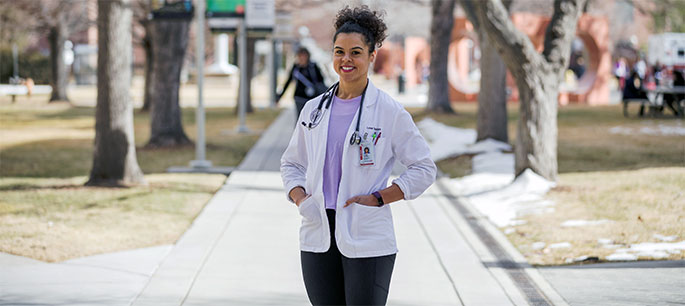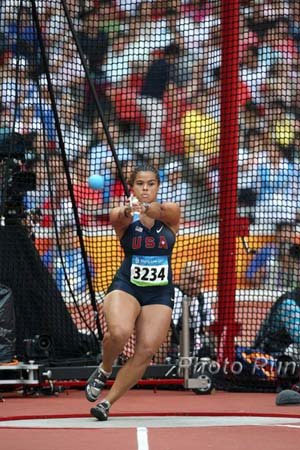From the Olympics to Medical School
Loree Thornton's new dream: Becoming a surgeon

By Amanda Blackman
(May 2018) From throwing a hammer in the Bird’s Nest stadium in Beijing during the 2008 Summer Olympics to studying to become a surgeon at CU Anschutz, Loree Thornton is no stranger to pushing herself to the limits in pursuit of her dreams.
Watching the 1996 Summer Olympics, Thornton knew she wanted to be an Olympian. She just didn’t know what her sport would be. She imagined competing in the games and meeting a Russian gymnast. She went so far as to take four years of Russian in high school.
“I was like, ‘I need to speak Russian so I can meet him,’” Thornton said with a laugh, “because, you know, I’d meet him and get married.”
But she didn’t even discover her event until she was in college when her coach suggested she the hammer throw.
“I was like, ‘Cool what’s that?’” Before that day, Thornton admitted, she’d never heard of hammer throwing. In track and field, the hammer is a metal ball that weighs about nine pounds and is attached to a steel wire. The athlete twirls the ball and releases to fly across the field.
“I think it picked me,” she said.
Breaking records
From that moment, Thornton worked toward the Olympics. At Colorado State University, she trained about four hours a day, ultimately setting a hammer-throw record.
“I broke the collegiate record – the farthest-throwing female to throw a hammer of all time,” said Thornton. “That’s why I think it chose me; I loved it.”
In 2008, she earned one of three spots on the U.S. hammer throwing team for the Summer Olympics in Beijing. She described walking into the Bird’s Nest stadium as a surreal experience. After devoting 10 years to her training, she was fulfilling a dream.
“You question yourself, you question the process, and then to walk into a stadium that’s vibrating with energy wearing
 Connection to Winter Olympics
Connection to Winter Olympics
Even though Thornton participated in the summer games, she feels a connection to the Winter Olympics because some former track teammates participate in bobsledding.
She most enjoys watching figure skating during the Winter Olympics. “I love figure skating. It’s really cool to see all those years of hard work come out so beautiful,” she said. “It’s where sport meets art.”
After the 2008 Olympics and four more years of throwing hammers, Thornton retired from competition in 2012 to pursue another dream: to become a surgeon. Being a doctor had always been on her mind, but she had doubted her abilities – even after going to the Olympics.
“I came from a pretty underprivileged background. Saying you want to be a doctor is on par with saying you want to be an astronaut. People don’t do that, not people like you,” she said. Going to the Olympics taught Thornton that any dream, even those that seem unattainable, can come true with enough hard work and dedication.
A new goal: surgeon
When she heard she had been accepted into CU School of Medicine class of 2020, she
“I thought, ‘I got my number one choice – I’m done!’” she said.
Training to become a surgeon doesn’t require long hours in the gym, but there are plenty of new challenges. Thornton said people suggest she should become an orthopedic surgeon; she is considering other specialties just to prove them wrong. Regardless of the surgical route she chooses, Thornton continues to work tirelessly.
“There are some weeks where I get five hours of sleep a night. I’m getting my butt kicked, and I’m tired, but then I go into